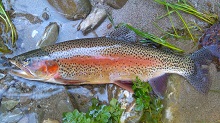Genetically Modified Atlantic Salmon Effects Wild Gene Pool
Canadian Angling.com (July 19, 2011) Canadian researchers have found that genetically modified Atlantic salmon can successfully bred with wild salmon and effect the wild genetic pool. Their recent research has been published in Evolutionary Applications, and looks at the genetic effects of commercial farming and discusses its implications. .
“The use of growth-enhancing transgenic technologies has long been of interest to the aquaculture industry and now genetically modified Atlantic salmon is one of the first species to be considered for commercial farming. Yet, little is known about the potential impact on wild salmon populations if the GM (genetically modified) species were to escape captivity,” said Darek Moreau, the lead author (Memorial University of Newfoundland, Canada).
Their concern is that the genetically modified fish will pass on their genes and out-compete the native fish. This would cause the offspring to be weaker genetically and could cause a species to become extinct. There has been no empirical research showing that the genetically modified fish could breed with the natural stock, until now.
In nature, there are two types of males that spawn with the female. The larger males which have migrated from the sea and the smaller males that stays in the rivers. The larger males are very aggressive and fight off all suitors for the female. The smaller male parr use bright colours to attract the female and use sneak fertilization to reproduce with the female. The scientists used a naturalized laboratory setting and genetic analysis to determine the success of the genetically modified salmon versus the larger and smaller wild male salmon.
What the scientists discovered was that the larger males outperformed the genetically modified Atlantic salmon in a variety of spawning behaviors and also the smaller, less aggressive parr were able to outperform them also (fertilization success)..
“While the transgenic males displayed reduced breeding performance relative to their non-transgenic rivals they still demonstrated the ability to successfully participate in natural spawning events and thus have the potential to contribute modified genes to wild populations,” said Moreau. The study only provided a general estimate of how the genetically modified salmon would do in the wild; it did mimic how the genetically modified genes could get into the wild genetic pool and effect the wild Atlantic salmon population.
“Our study provides the first empirical observations on the natural reproductive capacities of growth hormone transgenic Atlantic salmon,” Moreau concluded. “While the resulting ecological and genetic effects of a transgene escape remain uncertain, these data highlight the importance of preventing reproductively-viable GM (genetically modified) salmon from entering natural systems.”
Wayne Sheridan



